Strategic Management Report: TESCO Case Study Analysis and Strategies
VerifiedAdded on 2023/01/04
|17
|5416
|57
Report
AI Summary
This report provides a comprehensive analysis of TESCO's strategic management practices. It begins with an introduction to strategic management and its importance, followed by an examination of TESCO's strategies over the past five years, focusing on expansion. The report then delves into the competitive drivers influencing TESCO, utilizing PESTLE analysis to assess political, economic, social, technological, legal, and environmental factors. Furthermore, it applies Porter's Five Forces model to evaluate competitive rivalry, threats of new entrants, substitute goods, supplier power, and buyer power. Internal tools, particularly the Business Model Canvas (BMC), are employed to assess TESCO's vision, mission, objectives, and key business elements such as customer segments, value propositions, channels, customer relationships, revenue streams, key activities, resources, partners, and cost structure. The analysis concludes with a summary of findings and references.
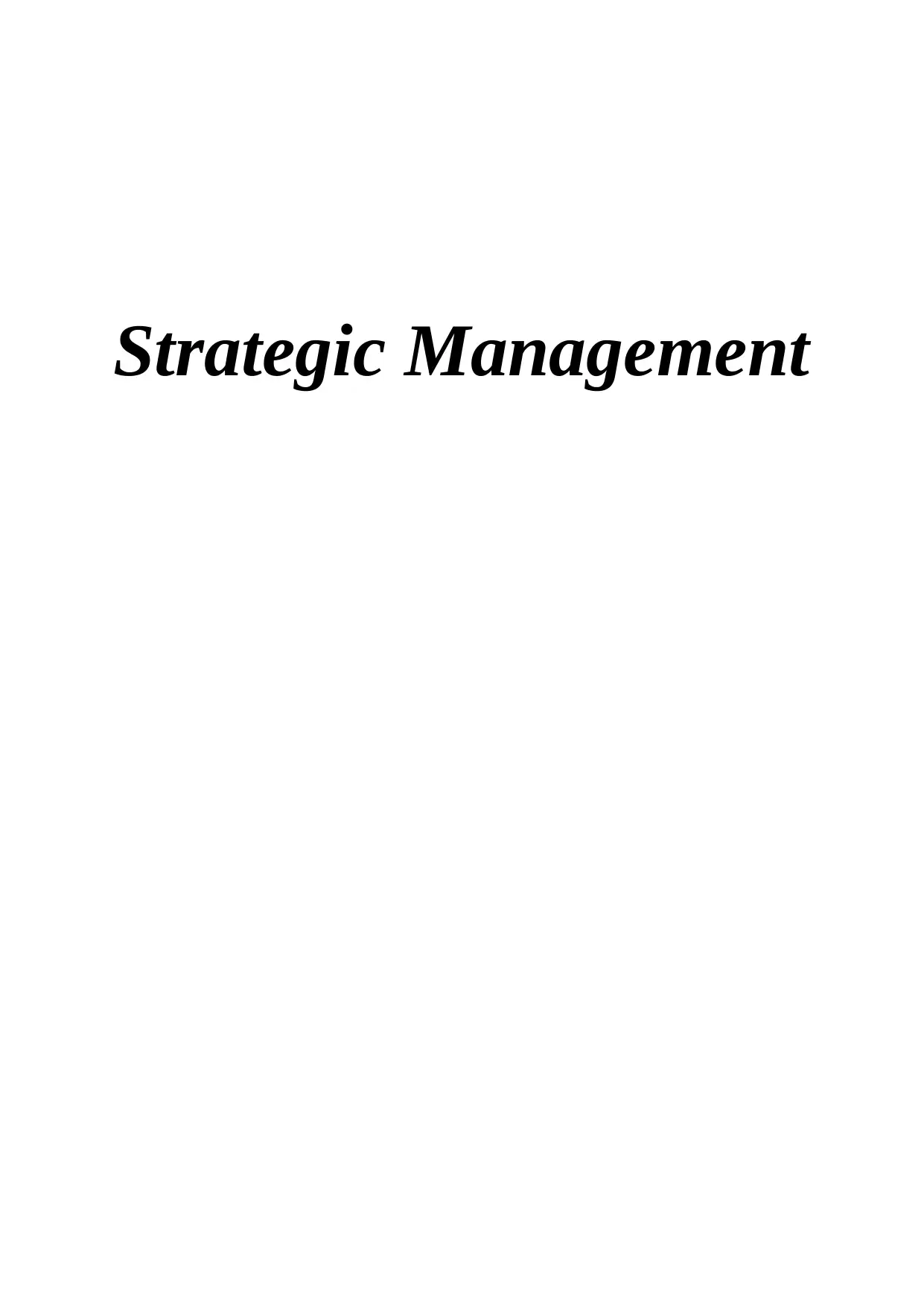
Strategic Management
Paraphrase This Document
Need a fresh take? Get an instant paraphrase of this document with our AI Paraphraser
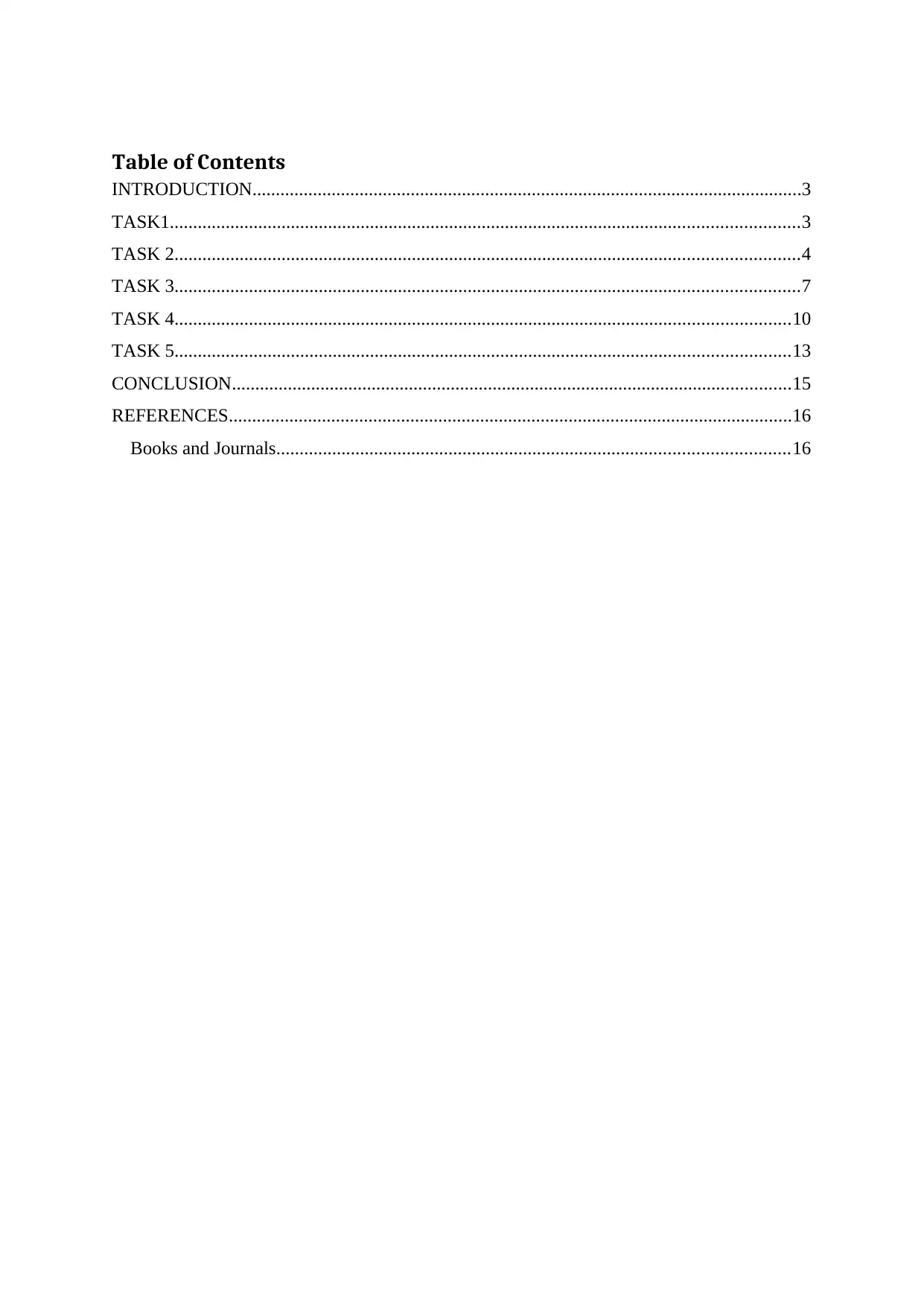
Table of Contents
INTRODUCTION......................................................................................................................3
TASK1.......................................................................................................................................3
TASK 2......................................................................................................................................4
TASK 3......................................................................................................................................7
TASK 4....................................................................................................................................10
TASK 5....................................................................................................................................13
CONCLUSION........................................................................................................................15
REFERENCES.........................................................................................................................16
Books and Journals..............................................................................................................16
INTRODUCTION......................................................................................................................3
TASK1.......................................................................................................................................3
TASK 2......................................................................................................................................4
TASK 3......................................................................................................................................7
TASK 4....................................................................................................................................10
TASK 5....................................................................................................................................13
CONCLUSION........................................................................................................................15
REFERENCES.........................................................................................................................16
Books and Journals..............................................................................................................16
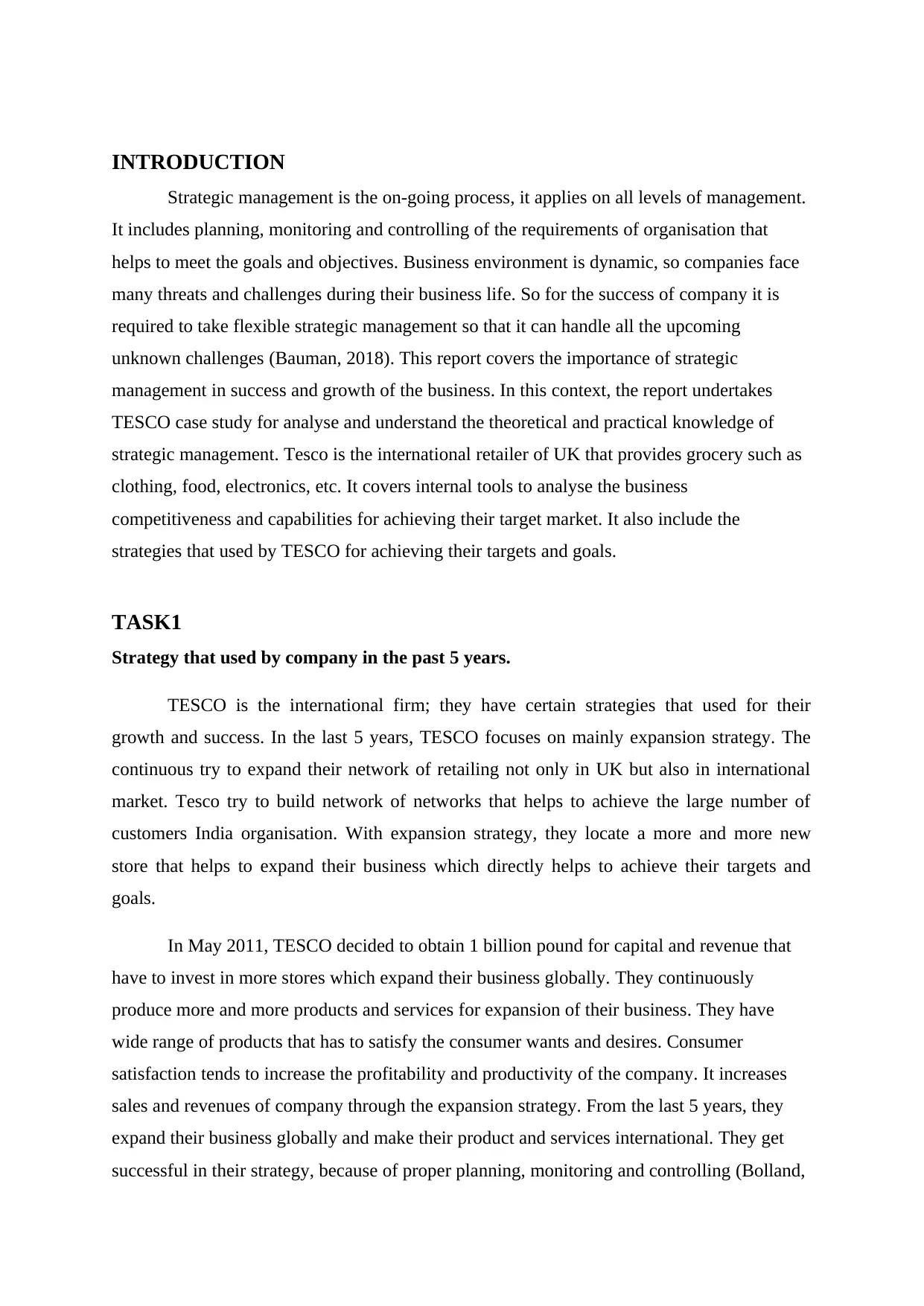
INTRODUCTION
Strategic management is the on-going process, it applies on all levels of management.
It includes planning, monitoring and controlling of the requirements of organisation that
helps to meet the goals and objectives. Business environment is dynamic, so companies face
many threats and challenges during their business life. So for the success of company it is
required to take flexible strategic management so that it can handle all the upcoming
unknown challenges (Bauman, 2018). This report covers the importance of strategic
management in success and growth of the business. In this context, the report undertakes
TESCO case study for analyse and understand the theoretical and practical knowledge of
strategic management. Tesco is the international retailer of UK that provides grocery such as
clothing, food, electronics, etc. It covers internal tools to analyse the business
competitiveness and capabilities for achieving their target market. It also include the
strategies that used by TESCO for achieving their targets and goals.
TASK1
Strategy that used by company in the past 5 years.
TESCO is the international firm; they have certain strategies that used for their
growth and success. In the last 5 years, TESCO focuses on mainly expansion strategy. The
continuous try to expand their network of retailing not only in UK but also in international
market. Tesco try to build network of networks that helps to achieve the large number of
customers India organisation. With expansion strategy, they locate a more and more new
store that helps to expand their business which directly helps to achieve their targets and
goals.
In May 2011, TESCO decided to obtain 1 billion pound for capital and revenue that
have to invest in more stores which expand their business globally. They continuously
produce more and more products and services for expansion of their business. They have
wide range of products that has to satisfy the consumer wants and desires. Consumer
satisfaction tends to increase the profitability and productivity of the company. It increases
sales and revenues of company through the expansion strategy. From the last 5 years, they
expand their business globally and make their product and services international. They get
successful in their strategy, because of proper planning, monitoring and controlling (Bolland,
Strategic management is the on-going process, it applies on all levels of management.
It includes planning, monitoring and controlling of the requirements of organisation that
helps to meet the goals and objectives. Business environment is dynamic, so companies face
many threats and challenges during their business life. So for the success of company it is
required to take flexible strategic management so that it can handle all the upcoming
unknown challenges (Bauman, 2018). This report covers the importance of strategic
management in success and growth of the business. In this context, the report undertakes
TESCO case study for analyse and understand the theoretical and practical knowledge of
strategic management. Tesco is the international retailer of UK that provides grocery such as
clothing, food, electronics, etc. It covers internal tools to analyse the business
competitiveness and capabilities for achieving their target market. It also include the
strategies that used by TESCO for achieving their targets and goals.
TASK1
Strategy that used by company in the past 5 years.
TESCO is the international firm; they have certain strategies that used for their
growth and success. In the last 5 years, TESCO focuses on mainly expansion strategy. The
continuous try to expand their network of retailing not only in UK but also in international
market. Tesco try to build network of networks that helps to achieve the large number of
customers India organisation. With expansion strategy, they locate a more and more new
store that helps to expand their business which directly helps to achieve their targets and
goals.
In May 2011, TESCO decided to obtain 1 billion pound for capital and revenue that
have to invest in more stores which expand their business globally. They continuously
produce more and more products and services for expansion of their business. They have
wide range of products that has to satisfy the consumer wants and desires. Consumer
satisfaction tends to increase the profitability and productivity of the company. It increases
sales and revenues of company through the expansion strategy. From the last 5 years, they
expand their business globally and make their product and services international. They get
successful in their strategy, because of proper planning, monitoring and controlling (Bolland,
⊘ This is a preview!⊘
Do you want full access?
Subscribe today to unlock all pages.

Trusted by 1+ million students worldwide
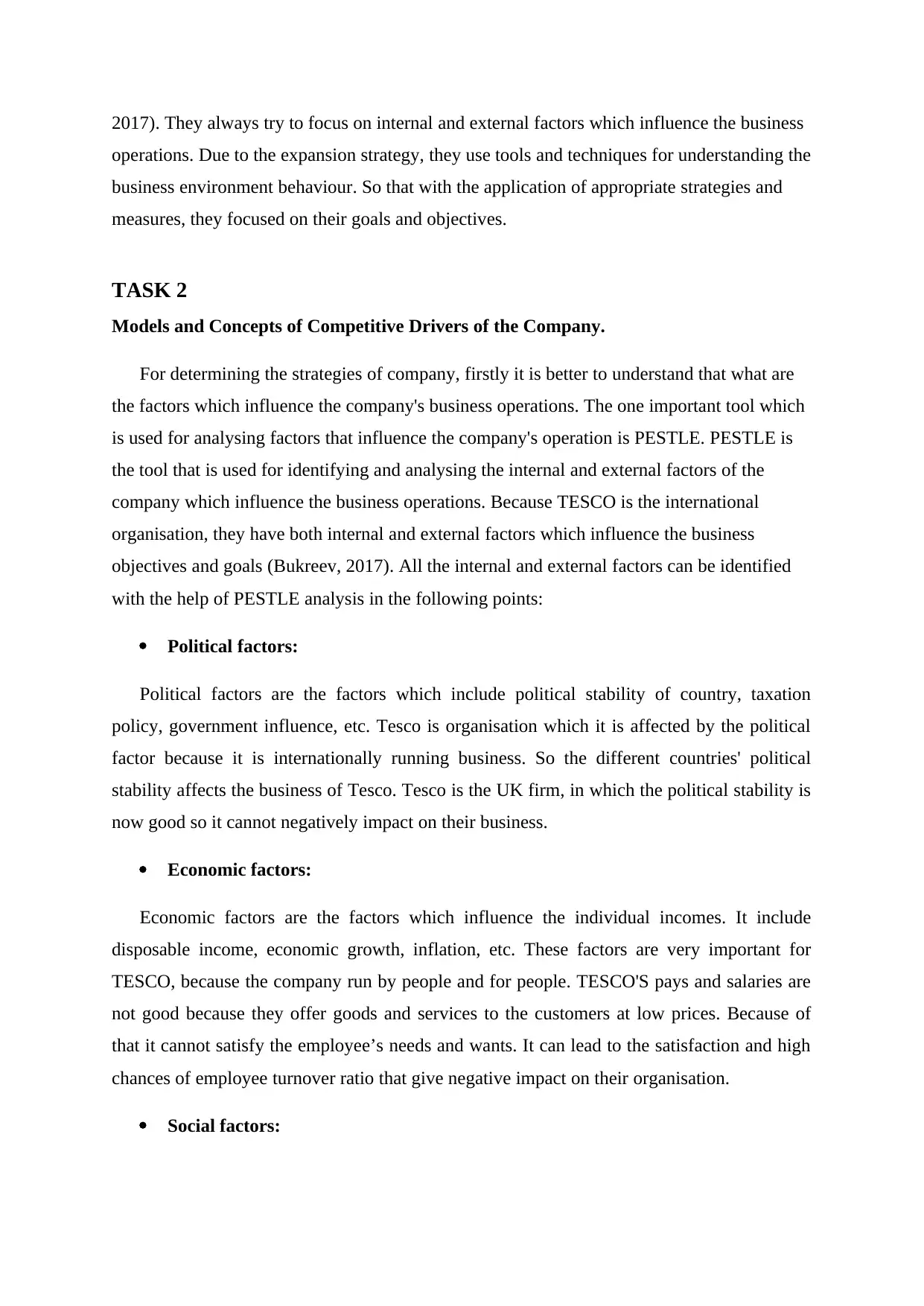
2017). They always try to focus on internal and external factors which influence the business
operations. Due to the expansion strategy, they use tools and techniques for understanding the
business environment behaviour. So that with the application of appropriate strategies and
measures, they focused on their goals and objectives.
TASK 2
Models and Concepts of Competitive Drivers of the Company.
For determining the strategies of company, firstly it is better to understand that what are
the factors which influence the company's business operations. The one important tool which
is used for analysing factors that influence the company's operation is PESTLE. PESTLE is
the tool that is used for identifying and analysing the internal and external factors of the
company which influence the business operations. Because TESCO is the international
organisation, they have both internal and external factors which influence the business
objectives and goals (Bukreev, 2017). All the internal and external factors can be identified
with the help of PESTLE analysis in the following points:
Political factors:
Political factors are the factors which include political stability of country, taxation
policy, government influence, etc. Tesco is organisation which it is affected by the political
factor because it is internationally running business. So the different countries' political
stability affects the business of Tesco. Tesco is the UK firm, in which the political stability is
now good so it cannot negatively impact on their business.
Economic factors:
Economic factors are the factors which influence the individual incomes. It include
disposable income, economic growth, inflation, etc. These factors are very important for
TESCO, because the company run by people and for people. TESCO'S pays and salaries are
not good because they offer goods and services to the customers at low prices. Because of
that it cannot satisfy the employee’s needs and wants. It can lead to the satisfaction and high
chances of employee turnover ratio that give negative impact on their organisation.
Social factors:
operations. Due to the expansion strategy, they use tools and techniques for understanding the
business environment behaviour. So that with the application of appropriate strategies and
measures, they focused on their goals and objectives.
TASK 2
Models and Concepts of Competitive Drivers of the Company.
For determining the strategies of company, firstly it is better to understand that what are
the factors which influence the company's business operations. The one important tool which
is used for analysing factors that influence the company's operation is PESTLE. PESTLE is
the tool that is used for identifying and analysing the internal and external factors of the
company which influence the business operations. Because TESCO is the international
organisation, they have both internal and external factors which influence the business
objectives and goals (Bukreev, 2017). All the internal and external factors can be identified
with the help of PESTLE analysis in the following points:
Political factors:
Political factors are the factors which include political stability of country, taxation
policy, government influence, etc. Tesco is organisation which it is affected by the political
factor because it is internationally running business. So the different countries' political
stability affects the business of Tesco. Tesco is the UK firm, in which the political stability is
now good so it cannot negatively impact on their business.
Economic factors:
Economic factors are the factors which influence the individual incomes. It include
disposable income, economic growth, inflation, etc. These factors are very important for
TESCO, because the company run by people and for people. TESCO'S pays and salaries are
not good because they offer goods and services to the customers at low prices. Because of
that it cannot satisfy the employee’s needs and wants. It can lead to the satisfaction and high
chances of employee turnover ratio that give negative impact on their organisation.
Social factors:
Paraphrase This Document
Need a fresh take? Get an instant paraphrase of this document with our AI Paraphraser
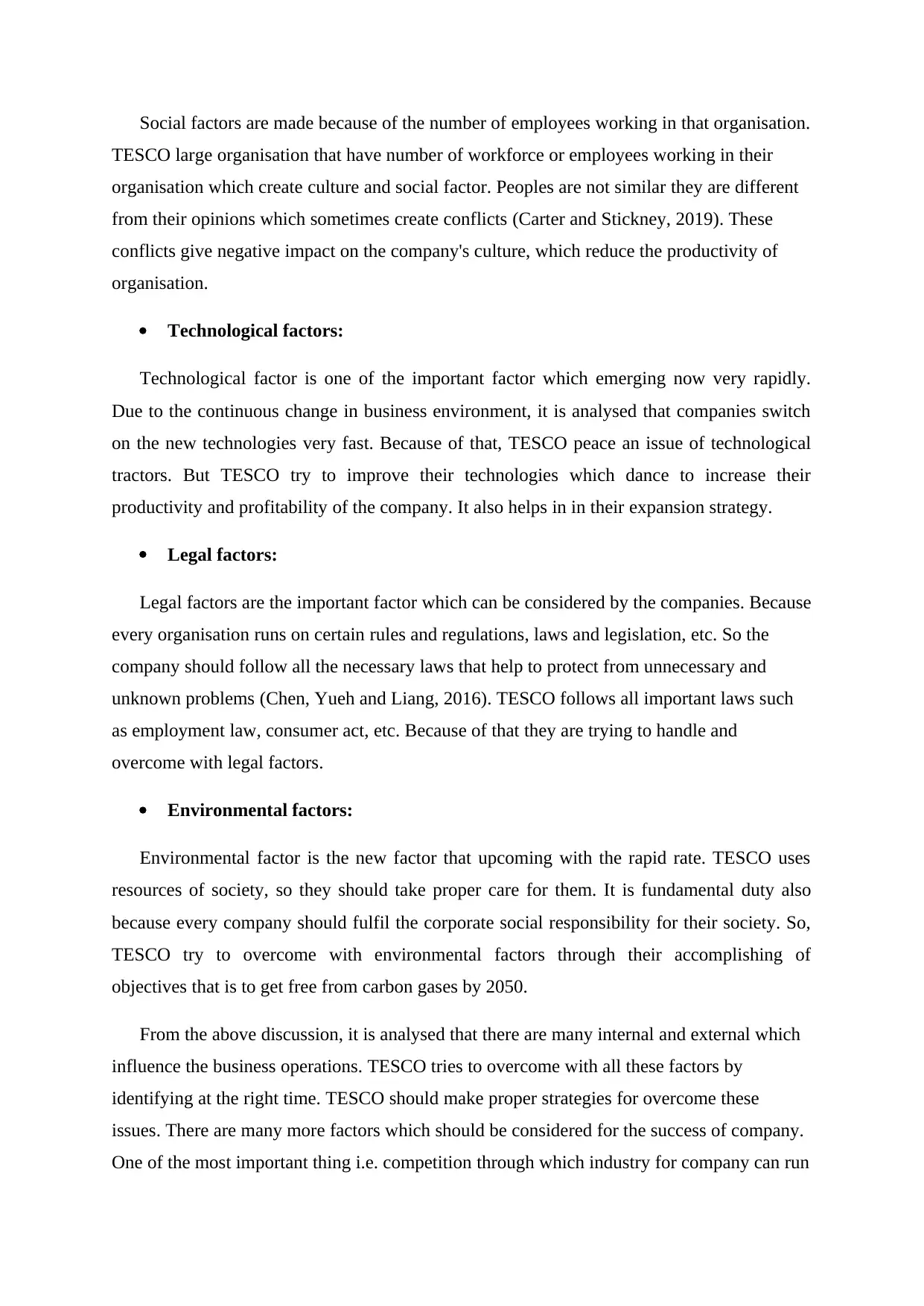
Social factors are made because of the number of employees working in that organisation.
TESCO large organisation that have number of workforce or employees working in their
organisation which create culture and social factor. Peoples are not similar they are different
from their opinions which sometimes create conflicts (Carter and Stickney, 2019). These
conflicts give negative impact on the company's culture, which reduce the productivity of
organisation.
Technological factors:
Technological factor is one of the important factor which emerging now very rapidly.
Due to the continuous change in business environment, it is analysed that companies switch
on the new technologies very fast. Because of that, TESCO peace an issue of technological
tractors. But TESCO try to improve their technologies which dance to increase their
productivity and profitability of the company. It also helps in in their expansion strategy.
Legal factors:
Legal factors are the important factor which can be considered by the companies. Because
every organisation runs on certain rules and regulations, laws and legislation, etc. So the
company should follow all the necessary laws that help to protect from unnecessary and
unknown problems (Chen, Yueh and Liang, 2016). TESCO follows all important laws such
as employment law, consumer act, etc. Because of that they are trying to handle and
overcome with legal factors.
Environmental factors:
Environmental factor is the new factor that upcoming with the rapid rate. TESCO uses
resources of society, so they should take proper care for them. It is fundamental duty also
because every company should fulfil the corporate social responsibility for their society. So,
TESCO try to overcome with environmental factors through their accomplishing of
objectives that is to get free from carbon gases by 2050.
From the above discussion, it is analysed that there are many internal and external which
influence the business operations. TESCO tries to overcome with all these factors by
identifying at the right time. TESCO should make proper strategies for overcome these
issues. There are many more factors which should be considered for the success of company.
One of the most important thing i.e. competition through which industry for company can run
TESCO large organisation that have number of workforce or employees working in their
organisation which create culture and social factor. Peoples are not similar they are different
from their opinions which sometimes create conflicts (Carter and Stickney, 2019). These
conflicts give negative impact on the company's culture, which reduce the productivity of
organisation.
Technological factors:
Technological factor is one of the important factor which emerging now very rapidly.
Due to the continuous change in business environment, it is analysed that companies switch
on the new technologies very fast. Because of that, TESCO peace an issue of technological
tractors. But TESCO try to improve their technologies which dance to increase their
productivity and profitability of the company. It also helps in in their expansion strategy.
Legal factors:
Legal factors are the important factor which can be considered by the companies. Because
every organisation runs on certain rules and regulations, laws and legislation, etc. So the
company should follow all the necessary laws that help to protect from unnecessary and
unknown problems (Chen, Yueh and Liang, 2016). TESCO follows all important laws such
as employment law, consumer act, etc. Because of that they are trying to handle and
overcome with legal factors.
Environmental factors:
Environmental factor is the new factor that upcoming with the rapid rate. TESCO uses
resources of society, so they should take proper care for them. It is fundamental duty also
because every company should fulfil the corporate social responsibility for their society. So,
TESCO try to overcome with environmental factors through their accomplishing of
objectives that is to get free from carbon gases by 2050.
From the above discussion, it is analysed that there are many internal and external which
influence the business operations. TESCO tries to overcome with all these factors by
identifying at the right time. TESCO should make proper strategies for overcome these
issues. There are many more factors which should be considered for the success of company.
One of the most important thing i.e. competition through which industry for company can run
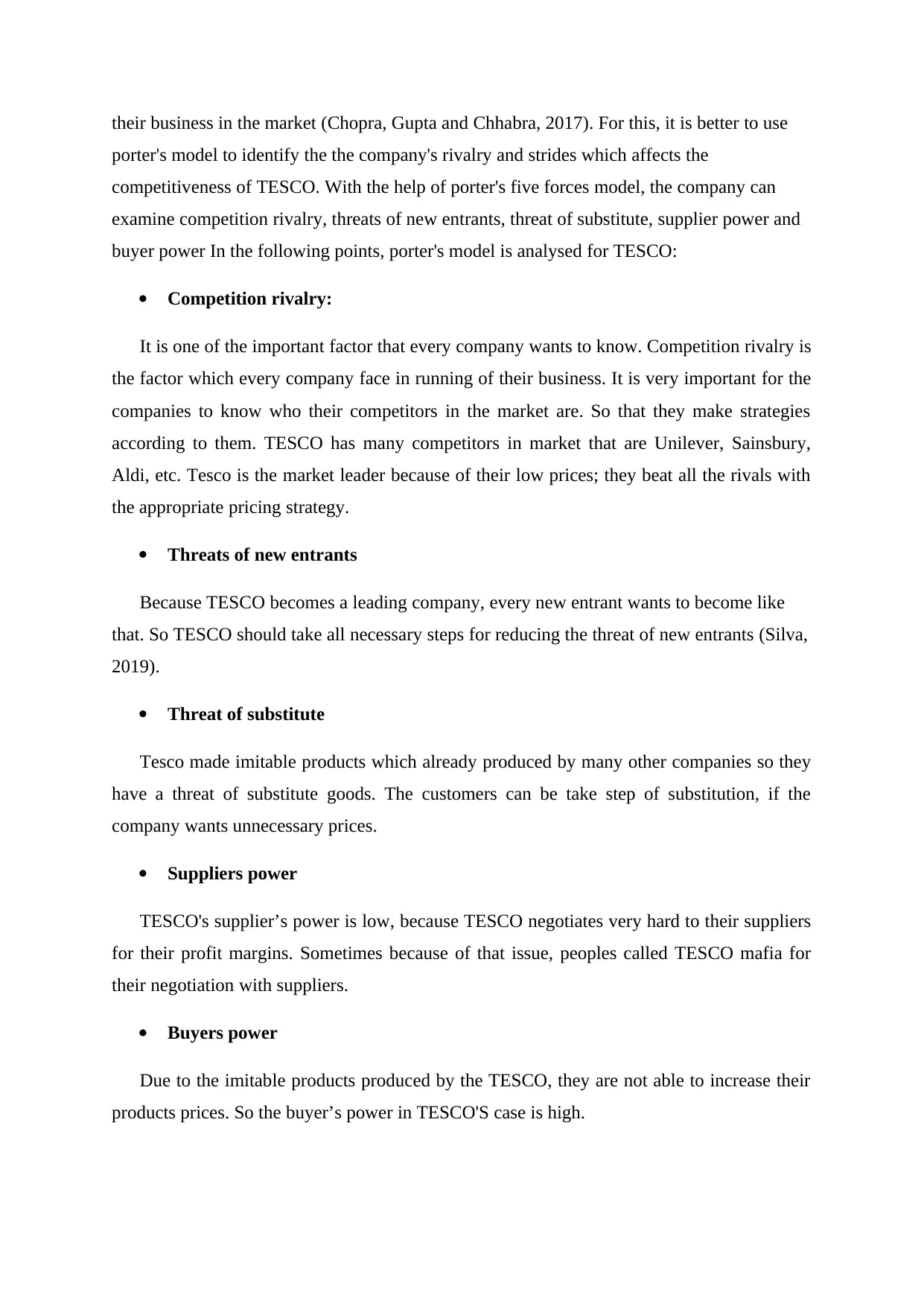
their business in the market (Chopra, Gupta and Chhabra, 2017). For this, it is better to use
porter's model to identify the the company's rivalry and strides which affects the
competitiveness of TESCO. With the help of porter's five forces model, the company can
examine competition rivalry, threats of new entrants, threat of substitute, supplier power and
buyer power In the following points, porter's model is analysed for TESCO:
Competition rivalry:
It is one of the important factor that every company wants to know. Competition rivalry is
the factor which every company face in running of their business. It is very important for the
companies to know who their competitors in the market are. So that they make strategies
according to them. TESCO has many competitors in market that are Unilever, Sainsbury,
Aldi, etc. Tesco is the market leader because of their low prices; they beat all the rivals with
the appropriate pricing strategy.
Threats of new entrants
Because TESCO becomes a leading company, every new entrant wants to become like
that. So TESCO should take all necessary steps for reducing the threat of new entrants (Silva,
2019).
Threat of substitute
Tesco made imitable products which already produced by many other companies so they
have a threat of substitute goods. The customers can be take step of substitution, if the
company wants unnecessary prices.
Suppliers power
TESCO's supplier’s power is low, because TESCO negotiates very hard to their suppliers
for their profit margins. Sometimes because of that issue, peoples called TESCO mafia for
their negotiation with suppliers.
Buyers power
Due to the imitable products produced by the TESCO, they are not able to increase their
products prices. So the buyer’s power in TESCO'S case is high.
porter's model to identify the the company's rivalry and strides which affects the
competitiveness of TESCO. With the help of porter's five forces model, the company can
examine competition rivalry, threats of new entrants, threat of substitute, supplier power and
buyer power In the following points, porter's model is analysed for TESCO:
Competition rivalry:
It is one of the important factor that every company wants to know. Competition rivalry is
the factor which every company face in running of their business. It is very important for the
companies to know who their competitors in the market are. So that they make strategies
according to them. TESCO has many competitors in market that are Unilever, Sainsbury,
Aldi, etc. Tesco is the market leader because of their low prices; they beat all the rivals with
the appropriate pricing strategy.
Threats of new entrants
Because TESCO becomes a leading company, every new entrant wants to become like
that. So TESCO should take all necessary steps for reducing the threat of new entrants (Silva,
2019).
Threat of substitute
Tesco made imitable products which already produced by many other companies so they
have a threat of substitute goods. The customers can be take step of substitution, if the
company wants unnecessary prices.
Suppliers power
TESCO's supplier’s power is low, because TESCO negotiates very hard to their suppliers
for their profit margins. Sometimes because of that issue, peoples called TESCO mafia for
their negotiation with suppliers.
Buyers power
Due to the imitable products produced by the TESCO, they are not able to increase their
products prices. So the buyer’s power in TESCO'S case is high.
⊘ This is a preview!⊘
Do you want full access?
Subscribe today to unlock all pages.

Trusted by 1+ million students worldwide
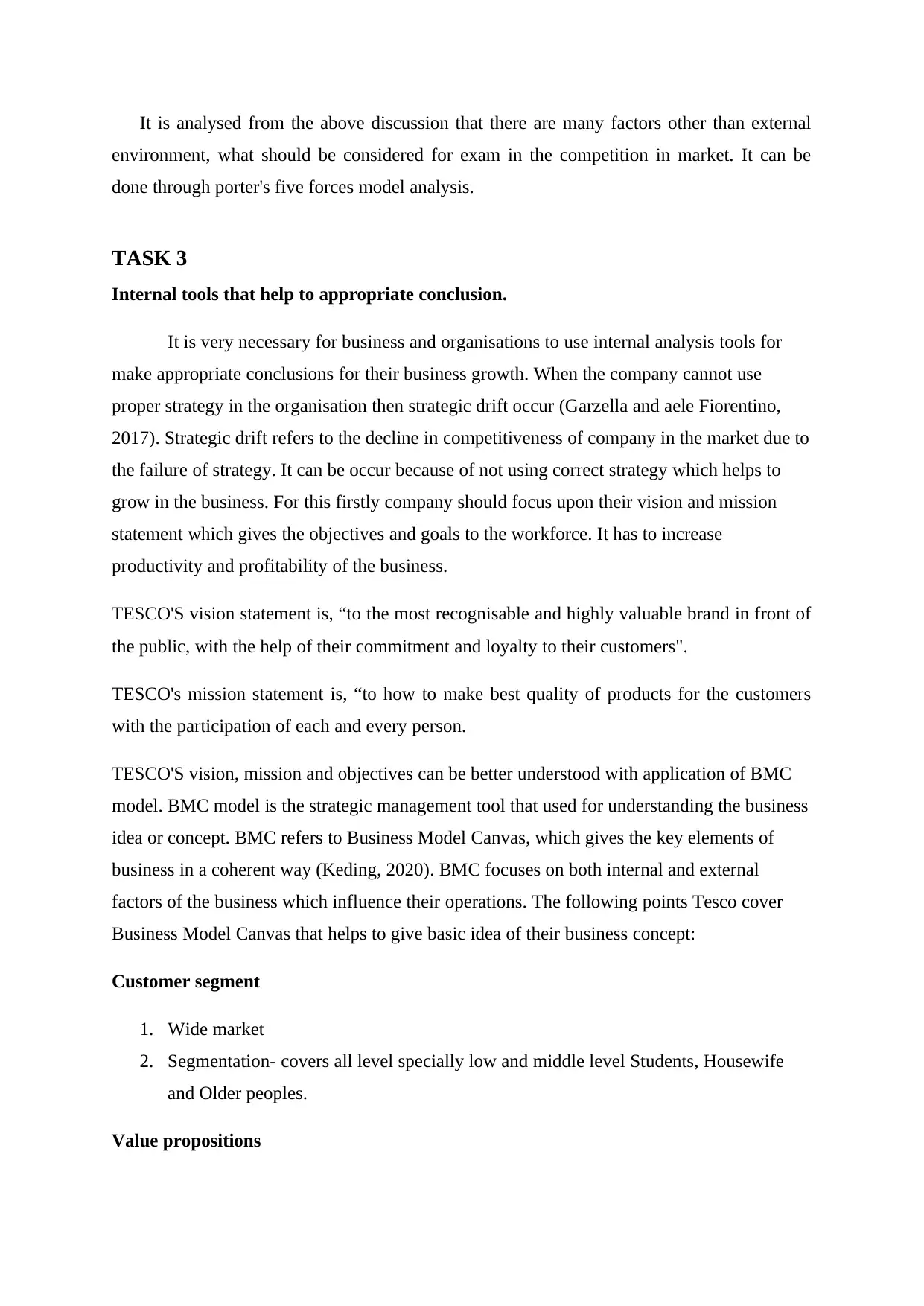
It is analysed from the above discussion that there are many factors other than external
environment, what should be considered for exam in the competition in market. It can be
done through porter's five forces model analysis.
TASK 3
Internal tools that help to appropriate conclusion.
It is very necessary for business and organisations to use internal analysis tools for
make appropriate conclusions for their business growth. When the company cannot use
proper strategy in the organisation then strategic drift occur (Garzella and aele Fiorentino,
2017). Strategic drift refers to the decline in competitiveness of company in the market due to
the failure of strategy. It can be occur because of not using correct strategy which helps to
grow in the business. For this firstly company should focus upon their vision and mission
statement which gives the objectives and goals to the workforce. It has to increase
productivity and profitability of the business.
TESCO'S vision statement is, “to the most recognisable and highly valuable brand in front of
the public, with the help of their commitment and loyalty to their customers".
TESCO's mission statement is, “to how to make best quality of products for the customers
with the participation of each and every person.
TESCO'S vision, mission and objectives can be better understood with application of BMC
model. BMC model is the strategic management tool that used for understanding the business
idea or concept. BMC refers to Business Model Canvas, which gives the key elements of
business in a coherent way (Keding, 2020). BMC focuses on both internal and external
factors of the business which influence their operations. The following points Tesco cover
Business Model Canvas that helps to give basic idea of their business concept:
Customer segment
1. Wide market
2. Segmentation- covers all level specially low and middle level Students, Housewife
and Older peoples.
Value propositions
environment, what should be considered for exam in the competition in market. It can be
done through porter's five forces model analysis.
TASK 3
Internal tools that help to appropriate conclusion.
It is very necessary for business and organisations to use internal analysis tools for
make appropriate conclusions for their business growth. When the company cannot use
proper strategy in the organisation then strategic drift occur (Garzella and aele Fiorentino,
2017). Strategic drift refers to the decline in competitiveness of company in the market due to
the failure of strategy. It can be occur because of not using correct strategy which helps to
grow in the business. For this firstly company should focus upon their vision and mission
statement which gives the objectives and goals to the workforce. It has to increase
productivity and profitability of the business.
TESCO'S vision statement is, “to the most recognisable and highly valuable brand in front of
the public, with the help of their commitment and loyalty to their customers".
TESCO's mission statement is, “to how to make best quality of products for the customers
with the participation of each and every person.
TESCO'S vision, mission and objectives can be better understood with application of BMC
model. BMC model is the strategic management tool that used for understanding the business
idea or concept. BMC refers to Business Model Canvas, which gives the key elements of
business in a coherent way (Keding, 2020). BMC focuses on both internal and external
factors of the business which influence their operations. The following points Tesco cover
Business Model Canvas that helps to give basic idea of their business concept:
Customer segment
1. Wide market
2. Segmentation- covers all level specially low and middle level Students, Housewife
and Older peoples.
Value propositions
Paraphrase This Document
Need a fresh take? Get an instant paraphrase of this document with our AI Paraphraser
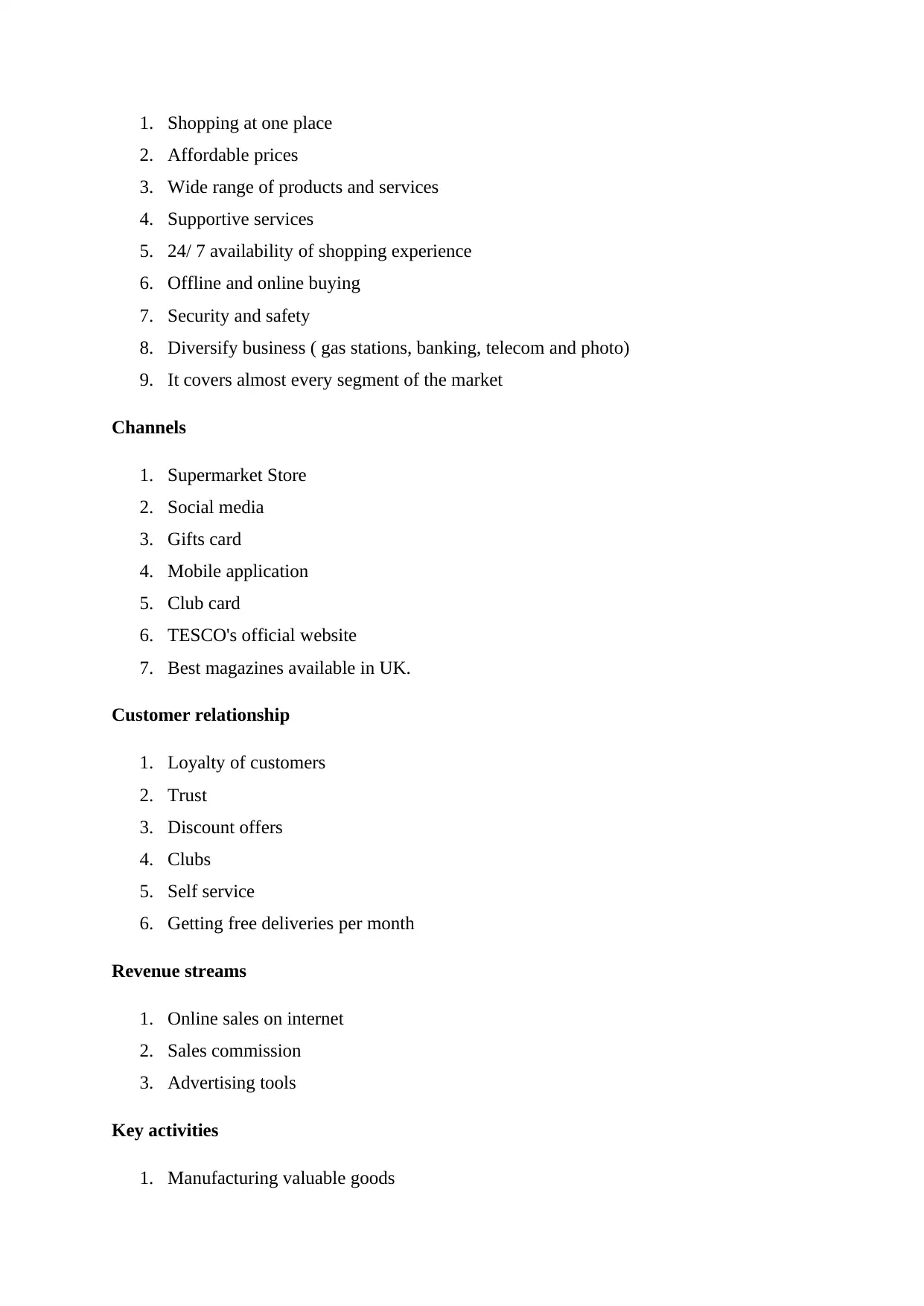
1. Shopping at one place
2. Affordable prices
3. Wide range of products and services
4. Supportive services
5. 24/ 7 availability of shopping experience
6. Offline and online buying
7. Security and safety
8. Diversify business ( gas stations, banking, telecom and photo)
9. It covers almost every segment of the market
Channels
1. Supermarket Store
2. Social media
3. Gifts card
4. Mobile application
5. Club card
6. TESCO's official website
7. Best magazines available in UK.
Customer relationship
1. Loyalty of customers
2. Trust
3. Discount offers
4. Clubs
5. Self service
6. Getting free deliveries per month
Revenue streams
1. Online sales on internet
2. Sales commission
3. Advertising tools
Key activities
1. Manufacturing valuable goods
2. Affordable prices
3. Wide range of products and services
4. Supportive services
5. 24/ 7 availability of shopping experience
6. Offline and online buying
7. Security and safety
8. Diversify business ( gas stations, banking, telecom and photo)
9. It covers almost every segment of the market
Channels
1. Supermarket Store
2. Social media
3. Gifts card
4. Mobile application
5. Club card
6. TESCO's official website
7. Best magazines available in UK.
Customer relationship
1. Loyalty of customers
2. Trust
3. Discount offers
4. Clubs
5. Self service
6. Getting free deliveries per month
Revenue streams
1. Online sales on internet
2. Sales commission
3. Advertising tools
Key activities
1. Manufacturing valuable goods
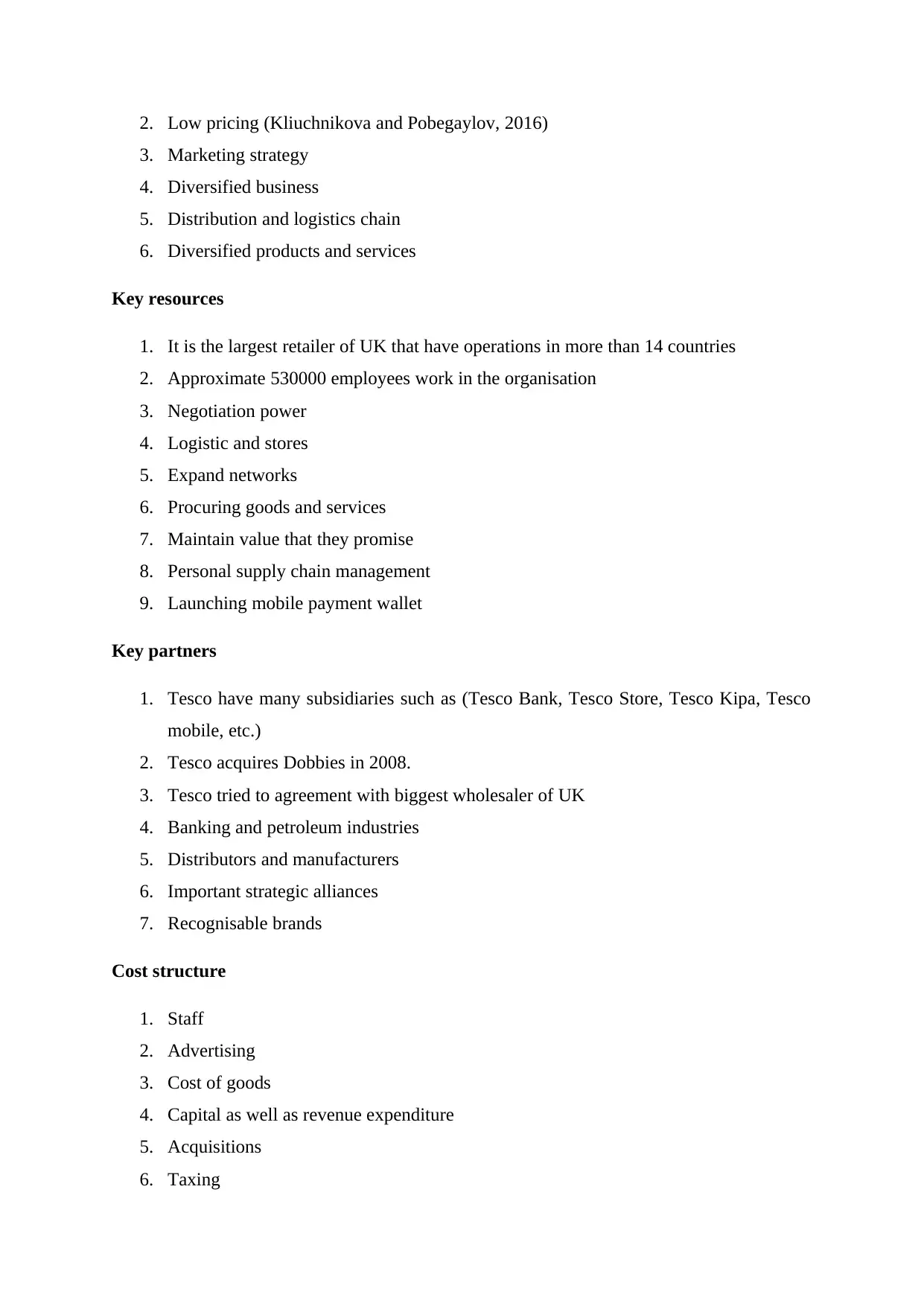
2. Low pricing (Kliuchnikova and Pobegaylov, 2016)
3. Marketing strategy
4. Diversified business
5. Distribution and logistics chain
6. Diversified products and services
Key resources
1. It is the largest retailer of UK that have operations in more than 14 countries
2. Approximate 530000 employees work in the organisation
3. Negotiation power
4. Logistic and stores
5. Expand networks
6. Procuring goods and services
7. Maintain value that they promise
8. Personal supply chain management
9. Launching mobile payment wallet
Key partners
1. Tesco have many subsidiaries such as (Tesco Bank, Tesco Store, Tesco Kipa, Tesco
mobile, etc.)
2. Tesco acquires Dobbies in 2008.
3. Tesco tried to agreement with biggest wholesaler of UK
4. Banking and petroleum industries
5. Distributors and manufacturers
6. Important strategic alliances
7. Recognisable brands
Cost structure
1. Staff
2. Advertising
3. Cost of goods
4. Capital as well as revenue expenditure
5. Acquisitions
6. Taxing
3. Marketing strategy
4. Diversified business
5. Distribution and logistics chain
6. Diversified products and services
Key resources
1. It is the largest retailer of UK that have operations in more than 14 countries
2. Approximate 530000 employees work in the organisation
3. Negotiation power
4. Logistic and stores
5. Expand networks
6. Procuring goods and services
7. Maintain value that they promise
8. Personal supply chain management
9. Launching mobile payment wallet
Key partners
1. Tesco have many subsidiaries such as (Tesco Bank, Tesco Store, Tesco Kipa, Tesco
mobile, etc.)
2. Tesco acquires Dobbies in 2008.
3. Tesco tried to agreement with biggest wholesaler of UK
4. Banking and petroleum industries
5. Distributors and manufacturers
6. Important strategic alliances
7. Recognisable brands
Cost structure
1. Staff
2. Advertising
3. Cost of goods
4. Capital as well as revenue expenditure
5. Acquisitions
6. Taxing
⊘ This is a preview!⊘
Do you want full access?
Subscribe today to unlock all pages.

Trusted by 1+ million students worldwide
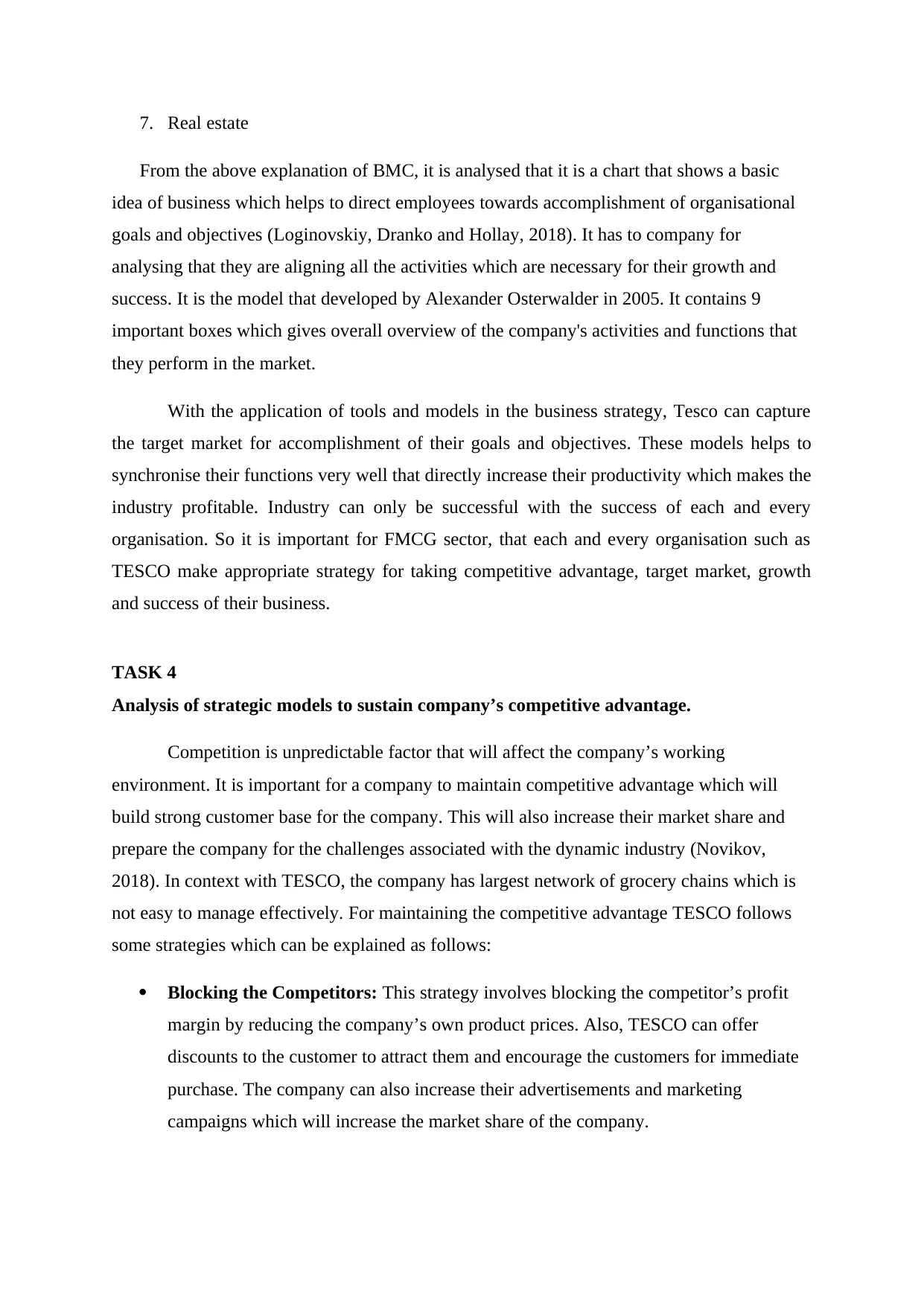
7. Real estate
From the above explanation of BMC, it is analysed that it is a chart that shows a basic
idea of business which helps to direct employees towards accomplishment of organisational
goals and objectives (Loginovskiy, Dranko and Hollay, 2018). It has to company for
analysing that they are aligning all the activities which are necessary for their growth and
success. It is the model that developed by Alexander Osterwalder in 2005. It contains 9
important boxes which gives overall overview of the company's activities and functions that
they perform in the market.
With the application of tools and models in the business strategy, Tesco can capture
the target market for accomplishment of their goals and objectives. These models helps to
synchronise their functions very well that directly increase their productivity which makes the
industry profitable. Industry can only be successful with the success of each and every
organisation. So it is important for FMCG sector, that each and every organisation such as
TESCO make appropriate strategy for taking competitive advantage, target market, growth
and success of their business.
TASK 4
Analysis of strategic models to sustain company’s competitive advantage.
Competition is unpredictable factor that will affect the company’s working
environment. It is important for a company to maintain competitive advantage which will
build strong customer base for the company. This will also increase their market share and
prepare the company for the challenges associated with the dynamic industry (Novikov,
2018). In context with TESCO, the company has largest network of grocery chains which is
not easy to manage effectively. For maintaining the competitive advantage TESCO follows
some strategies which can be explained as follows:
Blocking the Competitors: This strategy involves blocking the competitor’s profit
margin by reducing the company’s own product prices. Also, TESCO can offer
discounts to the customer to attract them and encourage the customers for immediate
purchase. The company can also increase their advertisements and marketing
campaigns which will increase the market share of the company.
From the above explanation of BMC, it is analysed that it is a chart that shows a basic
idea of business which helps to direct employees towards accomplishment of organisational
goals and objectives (Loginovskiy, Dranko and Hollay, 2018). It has to company for
analysing that they are aligning all the activities which are necessary for their growth and
success. It is the model that developed by Alexander Osterwalder in 2005. It contains 9
important boxes which gives overall overview of the company's activities and functions that
they perform in the market.
With the application of tools and models in the business strategy, Tesco can capture
the target market for accomplishment of their goals and objectives. These models helps to
synchronise their functions very well that directly increase their productivity which makes the
industry profitable. Industry can only be successful with the success of each and every
organisation. So it is important for FMCG sector, that each and every organisation such as
TESCO make appropriate strategy for taking competitive advantage, target market, growth
and success of their business.
TASK 4
Analysis of strategic models to sustain company’s competitive advantage.
Competition is unpredictable factor that will affect the company’s working
environment. It is important for a company to maintain competitive advantage which will
build strong customer base for the company. This will also increase their market share and
prepare the company for the challenges associated with the dynamic industry (Novikov,
2018). In context with TESCO, the company has largest network of grocery chains which is
not easy to manage effectively. For maintaining the competitive advantage TESCO follows
some strategies which can be explained as follows:
Blocking the Competitors: This strategy involves blocking the competitor’s profit
margin by reducing the company’s own product prices. Also, TESCO can offer
discounts to the customer to attract them and encourage the customers for immediate
purchase. The company can also increase their advertisements and marketing
campaigns which will increase the market share of the company.
Paraphrase This Document
Need a fresh take? Get an instant paraphrase of this document with our AI Paraphraser
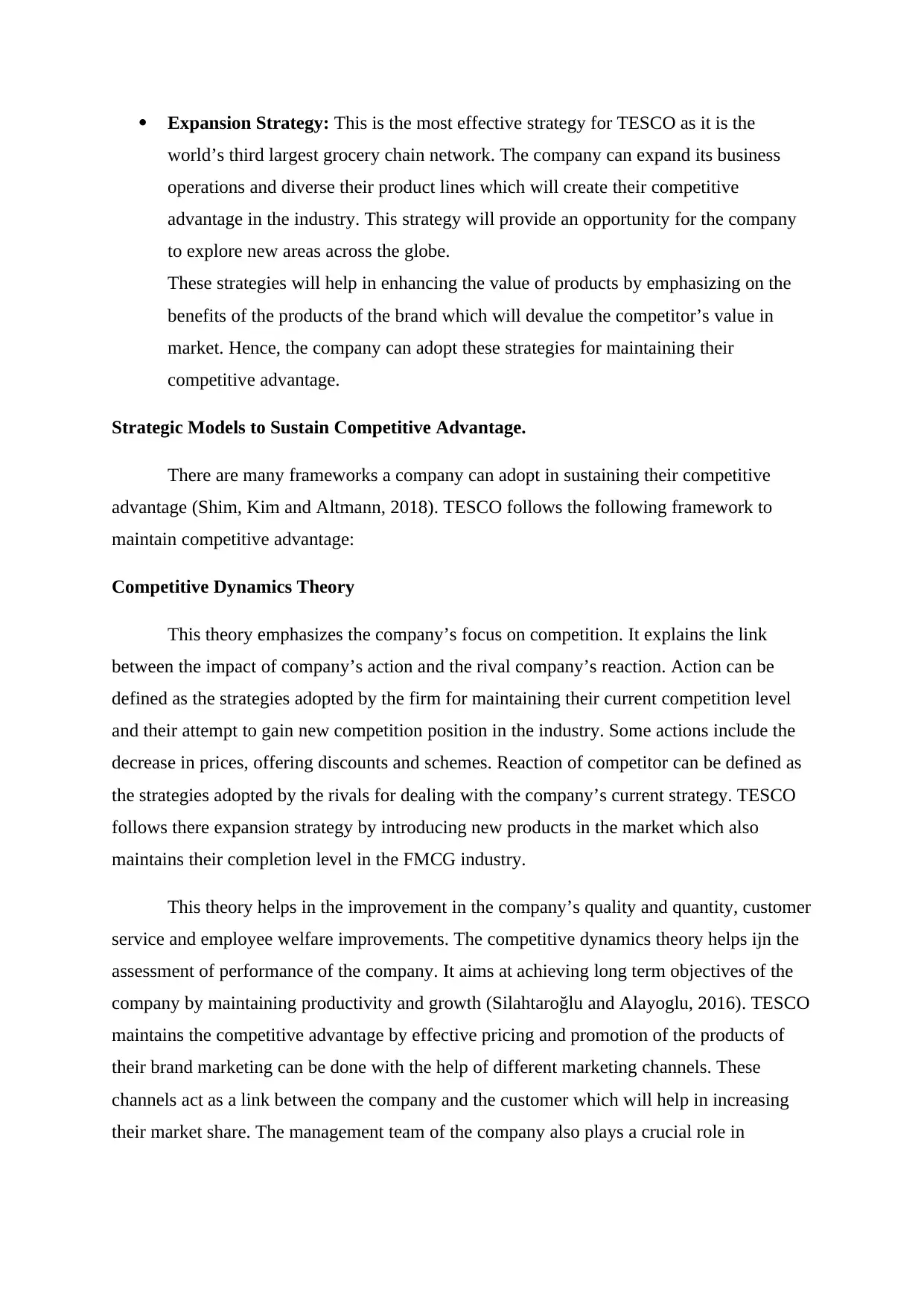
Expansion Strategy: This is the most effective strategy for TESCO as it is the
world’s third largest grocery chain network. The company can expand its business
operations and diverse their product lines which will create their competitive
advantage in the industry. This strategy will provide an opportunity for the company
to explore new areas across the globe.
These strategies will help in enhancing the value of products by emphasizing on the
benefits of the products of the brand which will devalue the competitor’s value in
market. Hence, the company can adopt these strategies for maintaining their
competitive advantage.
Strategic Models to Sustain Competitive Advantage.
There are many frameworks a company can adopt in sustaining their competitive
advantage (Shim, Kim and Altmann, 2018). TESCO follows the following framework to
maintain competitive advantage:
Competitive Dynamics Theory
This theory emphasizes the company’s focus on competition. It explains the link
between the impact of company’s action and the rival company’s reaction. Action can be
defined as the strategies adopted by the firm for maintaining their current competition level
and their attempt to gain new competition position in the industry. Some actions include the
decrease in prices, offering discounts and schemes. Reaction of competitor can be defined as
the strategies adopted by the rivals for dealing with the company’s current strategy. TESCO
follows there expansion strategy by introducing new products in the market which also
maintains their completion level in the FMCG industry.
This theory helps in the improvement in the company’s quality and quantity, customer
service and employee welfare improvements. The competitive dynamics theory helps ijn the
assessment of performance of the company. It aims at achieving long term objectives of the
company by maintaining productivity and growth (Silahtaroğlu and Alayoglu, 2016). TESCO
maintains the competitive advantage by effective pricing and promotion of the products of
their brand marketing can be done with the help of different marketing channels. These
channels act as a link between the company and the customer which will help in increasing
their market share. The management team of the company also plays a crucial role in
world’s third largest grocery chain network. The company can expand its business
operations and diverse their product lines which will create their competitive
advantage in the industry. This strategy will provide an opportunity for the company
to explore new areas across the globe.
These strategies will help in enhancing the value of products by emphasizing on the
benefits of the products of the brand which will devalue the competitor’s value in
market. Hence, the company can adopt these strategies for maintaining their
competitive advantage.
Strategic Models to Sustain Competitive Advantage.
There are many frameworks a company can adopt in sustaining their competitive
advantage (Shim, Kim and Altmann, 2018). TESCO follows the following framework to
maintain competitive advantage:
Competitive Dynamics Theory
This theory emphasizes the company’s focus on competition. It explains the link
between the impact of company’s action and the rival company’s reaction. Action can be
defined as the strategies adopted by the firm for maintaining their current competition level
and their attempt to gain new competition position in the industry. Some actions include the
decrease in prices, offering discounts and schemes. Reaction of competitor can be defined as
the strategies adopted by the rivals for dealing with the company’s current strategy. TESCO
follows there expansion strategy by introducing new products in the market which also
maintains their completion level in the FMCG industry.
This theory helps in the improvement in the company’s quality and quantity, customer
service and employee welfare improvements. The competitive dynamics theory helps ijn the
assessment of performance of the company. It aims at achieving long term objectives of the
company by maintaining productivity and growth (Silahtaroğlu and Alayoglu, 2016). TESCO
maintains the competitive advantage by effective pricing and promotion of the products of
their brand marketing can be done with the help of different marketing channels. These
channels act as a link between the company and the customer which will help in increasing
their market share. The management team of the company also plays a crucial role in
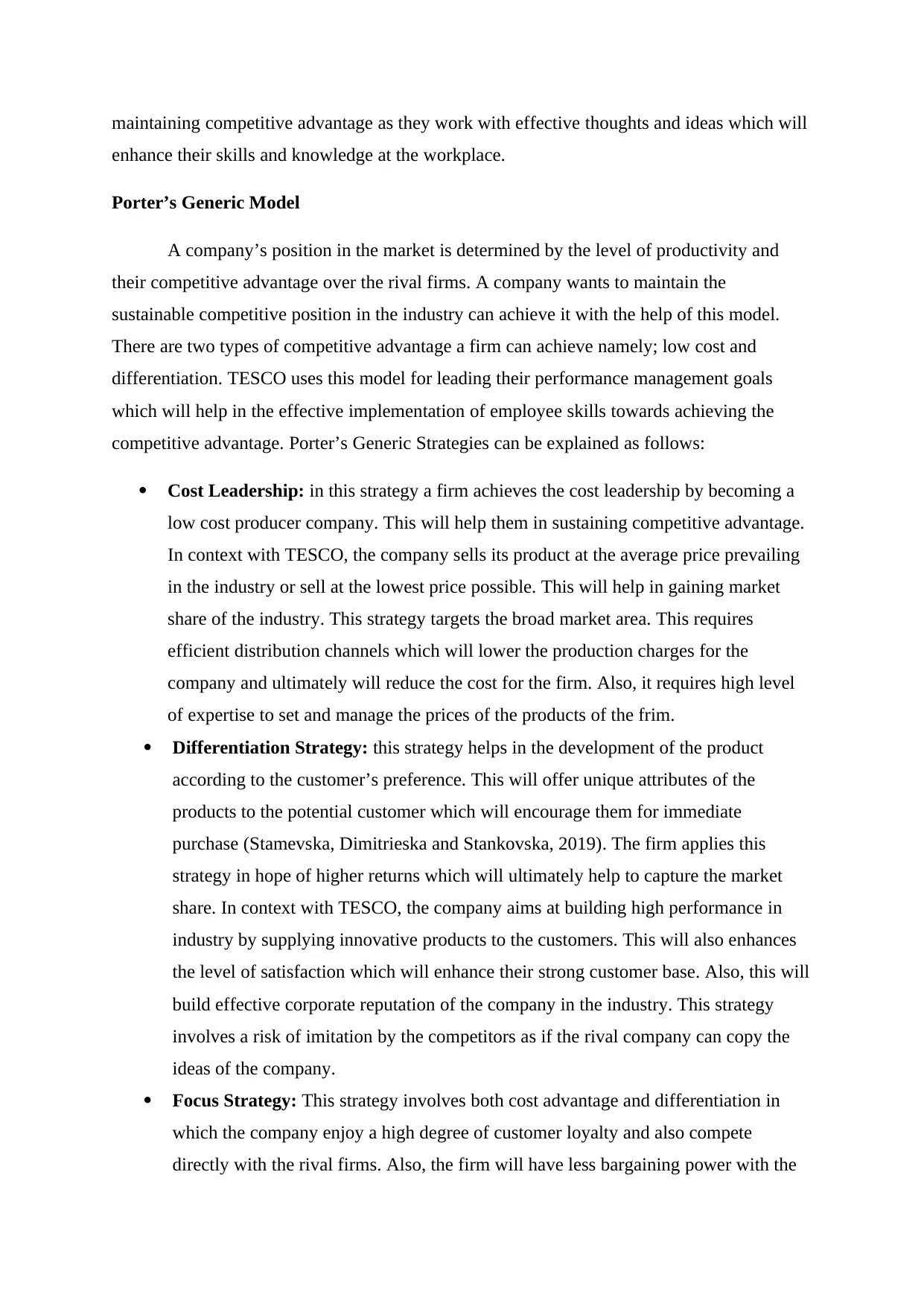
maintaining competitive advantage as they work with effective thoughts and ideas which will
enhance their skills and knowledge at the workplace.
Porter’s Generic Model
A company’s position in the market is determined by the level of productivity and
their competitive advantage over the rival firms. A company wants to maintain the
sustainable competitive position in the industry can achieve it with the help of this model.
There are two types of competitive advantage a firm can achieve namely; low cost and
differentiation. TESCO uses this model for leading their performance management goals
which will help in the effective implementation of employee skills towards achieving the
competitive advantage. Porter’s Generic Strategies can be explained as follows:
Cost Leadership: in this strategy a firm achieves the cost leadership by becoming a
low cost producer company. This will help them in sustaining competitive advantage.
In context with TESCO, the company sells its product at the average price prevailing
in the industry or sell at the lowest price possible. This will help in gaining market
share of the industry. This strategy targets the broad market area. This requires
efficient distribution channels which will lower the production charges for the
company and ultimately will reduce the cost for the firm. Also, it requires high level
of expertise to set and manage the prices of the products of the frim.
Differentiation Strategy: this strategy helps in the development of the product
according to the customer’s preference. This will offer unique attributes of the
products to the potential customer which will encourage them for immediate
purchase (Stamevska, Dimitrieska and Stankovska, 2019). The firm applies this
strategy in hope of higher returns which will ultimately help to capture the market
share. In context with TESCO, the company aims at building high performance in
industry by supplying innovative products to the customers. This will also enhances
the level of satisfaction which will enhance their strong customer base. Also, this will
build effective corporate reputation of the company in the industry. This strategy
involves a risk of imitation by the competitors as if the rival company can copy the
ideas of the company.
Focus Strategy: This strategy involves both cost advantage and differentiation in
which the company enjoy a high degree of customer loyalty and also compete
directly with the rival firms. Also, the firm will have less bargaining power with the
enhance their skills and knowledge at the workplace.
Porter’s Generic Model
A company’s position in the market is determined by the level of productivity and
their competitive advantage over the rival firms. A company wants to maintain the
sustainable competitive position in the industry can achieve it with the help of this model.
There are two types of competitive advantage a firm can achieve namely; low cost and
differentiation. TESCO uses this model for leading their performance management goals
which will help in the effective implementation of employee skills towards achieving the
competitive advantage. Porter’s Generic Strategies can be explained as follows:
Cost Leadership: in this strategy a firm achieves the cost leadership by becoming a
low cost producer company. This will help them in sustaining competitive advantage.
In context with TESCO, the company sells its product at the average price prevailing
in the industry or sell at the lowest price possible. This will help in gaining market
share of the industry. This strategy targets the broad market area. This requires
efficient distribution channels which will lower the production charges for the
company and ultimately will reduce the cost for the firm. Also, it requires high level
of expertise to set and manage the prices of the products of the frim.
Differentiation Strategy: this strategy helps in the development of the product
according to the customer’s preference. This will offer unique attributes of the
products to the potential customer which will encourage them for immediate
purchase (Stamevska, Dimitrieska and Stankovska, 2019). The firm applies this
strategy in hope of higher returns which will ultimately help to capture the market
share. In context with TESCO, the company aims at building high performance in
industry by supplying innovative products to the customers. This will also enhances
the level of satisfaction which will enhance their strong customer base. Also, this will
build effective corporate reputation of the company in the industry. This strategy
involves a risk of imitation by the competitors as if the rival company can copy the
ideas of the company.
Focus Strategy: This strategy involves both cost advantage and differentiation in
which the company enjoy a high degree of customer loyalty and also compete
directly with the rival firms. Also, the firm will have less bargaining power with the
⊘ This is a preview!⊘
Do you want full access?
Subscribe today to unlock all pages.

Trusted by 1+ million students worldwide
1 out of 17
Related Documents
Your All-in-One AI-Powered Toolkit for Academic Success.
+13062052269
info@desklib.com
Available 24*7 on WhatsApp / Email
![[object Object]](/_next/static/media/star-bottom.7253800d.svg)
Unlock your academic potential
Copyright © 2020–2025 A2Z Services. All Rights Reserved. Developed and managed by ZUCOL.





